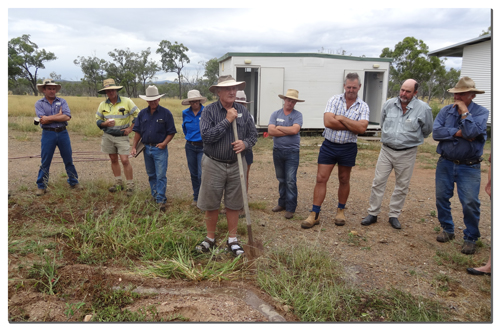Eighteen graziers from 12 enterprises attended a recent two-day NQ Dry Tropics Landscape Function Workshop, on Des Bolton’s 16,600ha Gadara Station in Greenvale.
The workshop, funded through the Australian Government Reef Programme, focused on reducing erosion by changing water flow patterns, and recapturing many of the nutrients that are lost when erosion occurs. It gave participants both theoretical and practical experience in building water spreading devices.
On day one, renowned agricultural pioneer Peter Andrews gave his expert view on landscape function, with a particular focus on Natural Sequence Farming.

Renowned agricultural pioneer Peter Andrews discusses landscape function at the NQ Dry Tropics Field Day.
“Livestock are managed in harmony with the Australian landscape to spread fertility from the floodplain to the hillsides to rejuvenate the whole farm landscape,” said Peter.
After a night in the swag and an early breakfast, day two kicked off in the field, where the group discussed the function of plants and their role in natural land and water systems.
After lunch the group moved to a number of sites, representing typical gully examples seen on grazing properties. Participants learnt about the types of structures that could be used to spread water and reduce gully erosion, ultimately reducing the impacts of sediment on the Great Barrier Reef.
A demonstration helped participants to understand how water flows in the landscape. They put this knowledge into practice by helping to survey structures along contours, under Peter’s instruction. They then constructed the structures using a bulldozer.
Des Bolton said he was happy to host the event, because he was very interested in Peter Andrews’ work, and how it could be applied to his soil conservation effort at Gadara.
Sam Skeet, NQ Dry Tropics Field Officer, added: “The workshop was held three hours drive north of Charters Towers, so it was impressive to see graziers coming from far and wide, including a group from Bowen and also from the Richmond area.”
Graziers said they particularly liked the practical demonstrations, and learnt useful information on how to control erosion, and where to end contours.
